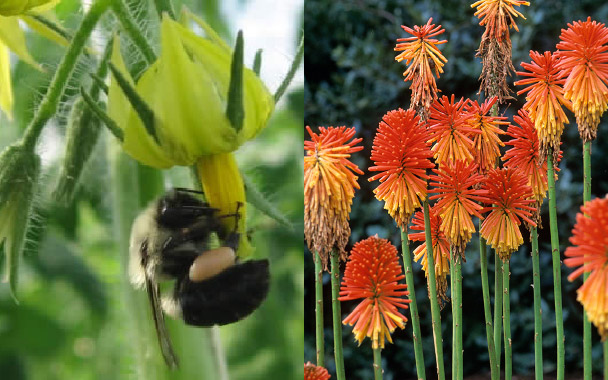When I tell you that our most recent garden additions have been Crocosmia ‘Lucifer’ and Red-Hot Poker, it doesn’t mean Stephen and I have crossed to the horticultural dark side. Or that in planting Gay Feather we were making a visual declaration of our support for gay rights (even though we did like the name). We simply wanted to invite pollinators into the garden, and these wildly colored flowers throw down the red carpet for bees, butterflies, and hummingbirds.
You may not have considered growing flowers amid your vegetables, especially when so many vegetables have beautiful blossoms of their own. But with honeybees succumbing to the still-mysterious colony collapse disorder and development cutting into natural habitats, pollinators need all the help we can give them. Flowers help to lure them in, and while they’re buzzing around your lilies they may also be encouraged to pollinate your squash. Is this pulling the old bait-and-switch routine? I think of it more as the all-the-nectar-you-can-eat Vegas buffet.
Brilliant red and yellow hues and tubular-shaped flowers attract hummingbirds, so Stephen suggested bulbs for paprika-red Crocosmia ‘Lucifer,’ a dramatic member of the iris family, and the spiky Red-Hot Poker (aka Torch Lily), along with some old standby orange marigolds (whose roots are toxic to nematodes, a garden pest). My sister, Diane, divided her runaway crop of Monarda didyma (bee balm) and gave me several plants, so that went in, too. Bee balm pulls double duty in the garden, with its edible flowers and leaves. It makes a delicious tea (the variety is also called Oswego tea, so named by settlers after observing Native Americans using it in a medicinal drink). An Adirondack forager I know introduced me to bee balm in the form of an herb jelly, and I’ve been eating it on my morning toast ever since. One caveat: Bee balm tends to get carried away, so if you do grow it, thin it regularly so it won’t take over your garden.
We’re planting for successive blooms throughout the season. The Gay Feather flowers in late summer, purple and fuzzy, like a bottle brush, and butterflies can’t get enough of it.
Like bee balm, I tend to get carried away (at least when it comes to growing flowers), and I had the idea to transplant a climbing rose from my shady cottage yard into the sun-filled vegetable patch to grow along our new “rabbit-proof” fence. But Stephen warned me off bringing in roses or nasturtiums (despite the latter’s lovely edible flowers)—they attract aphids. More bugs we don’t need.
And then Stephen got carried away with the design of the garden itself, building a swell path for us from the fieldstone we’d excavated from the soil. (I, on the other hand, had suggested wearing waterproof shoes to deal with the muddy paths, and to avoid lifting all those stones. Therein lies the difference between the professional gardener and the dilettante.) Then he brought in a couple of bright red deck chairs. I suppose they’re the right color for pollinators, but we’re really just envisioning the two of us at the end of a good day, cold beers and fresh tomatoes in hand, watching the birds and bees as they step up to the buffet.

